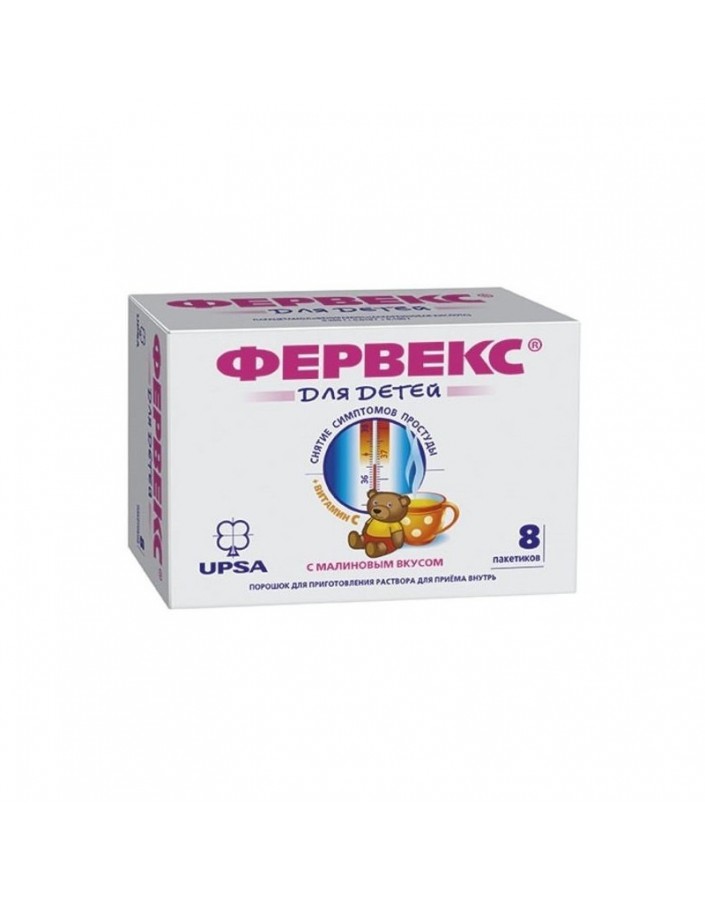




Security policy (edit with Customer reassurance module)

Delivery policy (edit with Customer reassurance module)

Return policy (edit with Customer reassurance module)
Combined drug.
Paracetamol has an analgesic and antipyretic effect.
Pheniramine - blocker H1-histamine receptors, reduces rhinorrhea and lacrimation, eliminates spasticity.
Ascorbic acid is involved in the regulation of redox processes, carbohydrate metabolism, blood clotting, tissue regeneration, in the synthesis of steroid hormones; reduces vascular permeability, reduces the need for Vitamins B1A b2, A, E, folic acid, pantothenic acid. It improves the tolerance of Paracetamol and prolongs its action (due to the elongation of T1/2).
- ARVI (symptomatic therapy);
- allergic rhinitis;
- rhinopharyngitis;
- pain syndrome (mild and moderate severity): arthralgia, myalgia, neuralgia, migraine, toothache and headache, algomenorrhea;
- pain with injuries, burns.
Insidefor adults (dosage form intended for adults) - 1 pack. 2-3 times / day.
For children (children's dosage form)6-10 years - 1 pack. 2 times / day10-12 years - 1 pack. 3 times / day12-15 years old - 1 pack. 4 times / day The interval between doses - at least 4 hours.
AtCKD (CC 10 ml / min) an interval between receptions - 8 h.
Allergic reactions (skin rash, itching, urticaria, angioedema), nausea, epigastric pain; anemia, thrombocytopenia; dry mouth, paresis of accommodation, urinary retention, drowsiness.
With prolonged use in large doses - hepatotoxic effect, hemolytic anemia, aplastic anemia, methemoglobinemia, pancytopenia; erosive and ulcerative lesions of the digestive tract, bleeding in the digestive tract; nephrotoxicity (papillary necrosis).
- hypersensitivity;
- portal hypertension;
- alcoholism;
- pregnancy (I and III trimesters);
- lactation period.
Ccaution: congenital hyperbilirubinemia (Gilbert, Dubin-Johnson and Rotor syndromes), children's age (up to 15 years for the dosage form intended for adults), children age (up to 6 years old for the infant dosage form), angle-closure glaucoma, prostatic hyperplasia, renal failure, deficiency of glucose-6-phosphate dehydrogenase.
Contraindications: pregnancy (I and III trimesters); lactation period.
Ccaution: renal failure.
AtCKD (CC 10 ml / min) an interval between receptions - 8 h.
With hyperthermia, lasting more than 3 days, and pain syndrome - more than 5 days, you should consult a doctor.
Distorts the performance of laboratory tests in the quantitative determination of glucose and uric acid in plasma.
During treatment, control of the picture of peripheral blood and the functional state of the liver is necessary.
During treatment, it is necessary to refrain from the use of ethanol (possibly the development of a hepatotoxic action).
Influence on ability to drive motor transport and control mechanisms
During the period of treatment, it is necessary to refrain from driving vehicles and engaging in other potentially hazardous activities that require high concentration of attention and psychomotor speed.
Symptoms (caused by paracetamol): pale skin, decreased appetite, nausea, vomiting; hepatonecrosis (severity of necrosis due to intoxication directly depends on the degree of overdose). Toxic effects in adults are possible after taking more than 10-15 g of paracetamol: increased activity of hepatic transaminases, an increase in prothrombin time (12-48 hours after administration); A detailed clinical picture of liver damage occurs after 1-6 days. Rarely, liver failure develops with lightning speed and may be complicated by renal failure (tubular necrosis).
Treatment: in the first 6 hours after the overdose - gastric lavage, the introduction of SH-group donators and the precursors of the synthesis of glutathione - methionine 8-9 hours after the overdose, and N-acetylcysteine 12 hours later
The need for additional therapeutic measures (the further introduction of methionine, in / in the introduction of N-acetylcysteine) is determined by the concentration of paracetamol in the blood, as well as the time that has passed since taking it.
Ethanol enhances the sedative effect of antihistamine drugs.
Antidepressants, anti-parkinsonian, antipsychotic drugs (phenothiazine derivatives) increase the risk of side effects (urinary retention, dry mouth, constipation).
GCS increase the risk of developing glaucoma.
Inductors of microsomal oxidation (phenytoin, ethanol, barbiturates, rifampicin, phenylbutazone, tricyclic antidepressants) increase the production of hydroxylated active metabolites, increasing the risk of severe intoxication with small overdoses.
Inhibitors of microsomal oxidation (cimetidine) reduce the risk of hepatotoxic action.
Paracetamol reduces the efficacy of uricosuric drugs.